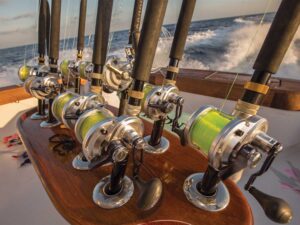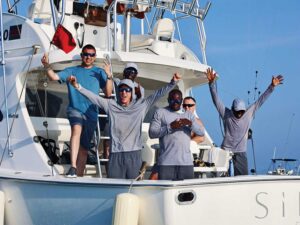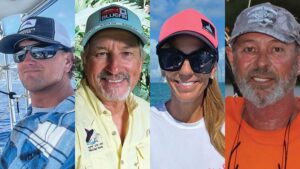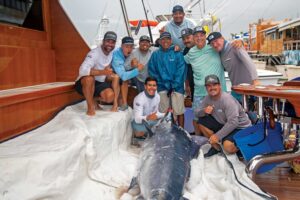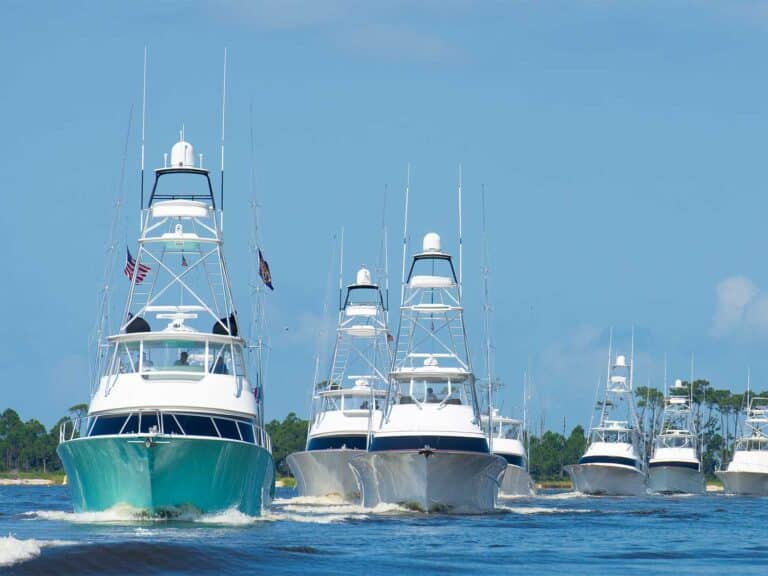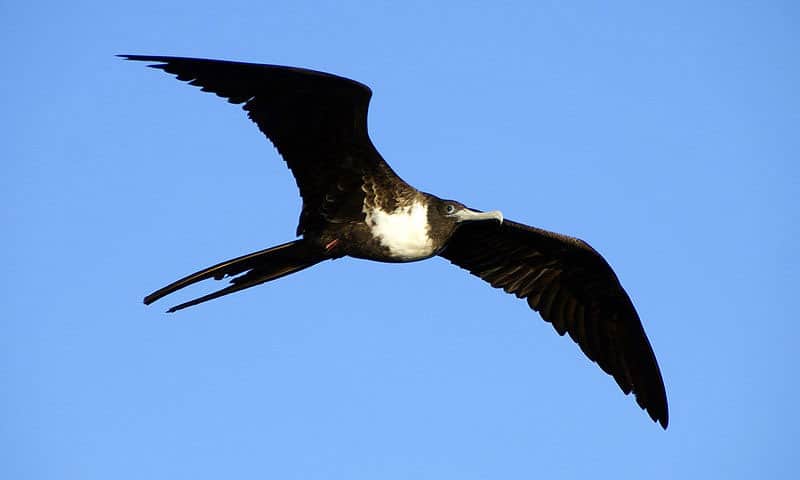
Sea Bird
“Birds!” It’s a shout from the bridge that’s sure to get any angler’s heart racing. A quick scan of the horizon, and there they are: Maybe it’s a knot of gannets divebombing yellowfin tuna or a pair of frigate birds swooping in low to pick off flying fish in front of a cruising marlin. No doubt about it — birds mean business offshore. Marine life is not equally distributed across the deep oceans of the world — it’s concentrated in small pockets. Bottom structure, currents and tides, upwellings and other factors help shape these pockets that hold the majority of marine life, including baitfish and pelagic species. And few of nature’s creatures are better equipped to locate these areas of bounty than seabirds.
Scientific Advantages
Birds possess several natural advantages that make them superb seagoing hunters — the power of flight being the first and most obvious. As the high towers on most serious sport-fishers demonstrate, altitude gives you an incredible advantage when trying to locate activity down deep or at a distance. Any gain in elevation allows the captain to not only see farther toward the horizon, but also peer down into the water at a better angle to see far below the surface. A bird soars hundreds of feet over the ocean’s surface, where the view literally stretches for miles in every direction.
Combine this with a bird’s high-power vision, and it’s a very potent combination. It’s hard to say just how well certain bird species see, but it’s pretty much a given that they have excellent long-range vision. Birds are also tuned into the visual cues from one another. When one diving gannet’s wings flash white in the sun, it’s a visual cue that’s seen by others for miles around — it’s the reason why one feeding bird turns into 50 in just a matter of minutes.
Then there’s their sense of smell. Some species of seabirds smell baitfish extremely well, and at much greater ranges than humans. David Lee, the recently retired curator of birds at the North Carolina State Museum of Natural History, says that storm petrels and other low-flying species use their sense of smell to detect fish oils released by baitfish. “You’ll see them tacking back and forth into the breeze like sailboats,” he says. “Once they find the scent, they’ll head upwind until they locate the source, which may be quite a long distance away — a couple of miles or more. They may not feed on the larger baitfish, but it’s still a pretty good indicator of a concentration of predators and prey.”
Species like shearwaters feature external, tube-shaped nostrils located on top of their beaks that help further improve their olfaction. Like a good bird dog, some seabirds can smell the game way before anyone else.
So which bird species are the biggest players in the offshore game? Lee says that the most important species are frigate birds, shearwaters, boobies, terns and storm petrels, with pelicans and gulls sharing a lesser role.
The Man with the Frigate Tattoo
Few skippers have as much experience throughout the Atlantic, the Caribbean and the Pacific as Capt. Bubba Carter. From 1986 to 1997, he fished out of Costa Rica, before moving his operation to Venezuela, where he fished the marlin-rich water of the La Guaira Bank. He named his first charter boat Tijereta (pronounced tee-her-EET-ah), which means “scissor” in Spanish, and is the nickname for the scissor-tailed frigate. His fourth Tijereta is now based out of Los Sueños Resort and Marina in Costa Rica. When asked why he chose the name, Carter replied simply, “Because the frigate birds are always on the fish.” In the early days, his mates would actually sunburn their necks as they looked skyward for the soaring black birds. “If you see one or two circling up high in a certain spot, you can be sure they’re watching something. It might be a marlin swimming deep or a school of bait, but they’re circling for a reason,” he says.
And if those same frigate birds begin to swoop low over the waves, head that direction. Frigates feed by intercepting flying fish and other bait off the ocean’s surface, rather than diving into the sea, so a low pass means that baitfish are right on the surface, often pushed up by marlin, sailfish and big dolphin.
Frigate birds also play an important role in the Atlantic, especially in the winter sailfish fishery off Isla Mujeres, Mexico. Like a brightly glowing neon sign that says “Fish Here,” large knots of frigates signal the presence of baitballs and sailfish below. One captain who’s spent plenty of time chasing both the birds and sails, Arch Bracher, often points his 56-foot Paul Mann charter boat, Pelican, south for the winter from his home port in North Carolina’s Oregon Inlet Fishing Center. “This past year we were pretty much fishing right out front for the first half of the season,” he says. “There were some highfliers over bait, and others were on bonito, and there would be a few frigates on bait here and there, but for the most part, it was a straight trolling bite. During the last half of the season, however, everything shifted: You had to find the frigates working on the baitballs to catch sails.”
Bracher reported seeing small schools of sardines (about the size of a hula hoop) that would have 50 or 60 sailfish corralling them tightly into a ball, always with a feathery swarm of frigate birds overhead. “We would fish one ball of bait and then see another one a quarter mile in front of the boat, so we’d troll that way. You’d think there would be a few sailfish scattered in between the two, but that wasn’t the case — you had to be fishing right around the birds to get a bite.”
The Carolina Connection
Back home in North Carolina, Bracher’s focus shifts from frigates to shearwaters, especially for white marlin. “A lot of times we’ll catch white marlin without a bird in sight, where they just pop up behind the boat. But on those really big-number days from the year before, there were always shearwaters involved.” These brown, gull-size seabirds are usually found close to the surface of the ocean, gliding along as they look for small minnows and other prey. “Sometimes they would be sitting on the water poking their heads down and feeding right over the top of the white marlin. They’re probably the most important offshore bird species for tuna and marlin, with the larger ones being a better indicator,” Bracher says. “However, they’re only around when the marlin are actively cutting on the surface, which is only about 50 percent of the time.” In other words, the absence of shearwaters doesn’t necessarily mean that you won’t get a bite out of a white marlin.
Bracher also says it’s important for the captain to relate what he’s seeing in terms of bird life with the location, time of the year and water depth. He points out that the presence of a particular bird species could mean different things. For example, shearwaters and terns in June below the Point at Hatteras most likely signal the presence of yellowfin tuna, whereas if you see them farther offshore north of the Point in August, it could mean white marlin. Having the local knowledge to fit the bird activity into the right part of the offshore puzzle certainly helps in situations like this.
South of the Border
Capt. Josh Temple is another skipper who specializes in finding birds. Based out of the fish-rich coastal town of Puerto Vallarta, Mexico, Temple starts his run offshore with a good pair of gyrostabilized binoculars close at hand. “I’m constantly scanning for frigate birds, terns, boobies or anything else that would indicate the presence of baitfish and/or game fish,” he reports. “Single birds flying in what I call ‘search mode’ aren’t enough for me to stop and investigate. But when I find several frigates that are actively feeding — circling, diving, dipping or outright crashing the water — that’s worth a pass or two. And if you see more than one species working the same school of bait — frigates mixed with boobies, gannets and terns, for example — then it’s a pretty good indicator that you’re on to something.”
He also says the presence of certain species can determine the size of the fish you may encounter underneath them. “It’s not always accurate, but the larger birds like frigates, boobies and the like can indicate fairly substantial game fish, since they tend to feed on larger baitfish and squid. Again, this is a very general rule: Sometimes terns or gulls will also give away the position of a school of big yellowfin tuna feeding on very small minnows. Then the size of the birds can also provide a clue as to what the fish may be feeding on as well.”
In the Grass
Birds can also help captains locate another fish aggregator: weed lines. Several species of terns are especially fond of sargassum weed, foraging for small minnows, sea horses, crabs and other inhabitants of the floating rafts of gold. It’s the same cover and small prey that attract game fish like dolphin and wahoo to these buffet lines, which in turn can lead to excellent fishing and often a shot at larger pelagic species like blue marlin. Bracher often sees shearwaters and terns picking over minnows in patches of scattered grass off the Carolinas and says that this is usually a good sign of the presence of yellowfin tuna as well.
Long-Range Detection
Given the importance of locating birds at sea, all three captains rely on a combination of radar and visual detection, either through binoculars or the old-fashioned eyeball. Temple, like most West Coast captains, leans heavily on specialty binoculars featuring an internal gyroscopic stabilizer for a clearer image at long ranges. It takes a lot of practice and a good pair of gyros, but the results can be quite spectacular.
“My personal record for locating a school of big tuna, thanks to the hundreds of birds that were feeding over them, is 15 miles,” he says. “I’m not looking for individual birds, but rather for the miragelike image that appears more like a dark, shifting shadow just above the horizon. It looks more like a half setting sun and is never very high in the sky, but with practice you can find birds at some pretty remarkable ranges.” The gyros are also handy for checking the surface of the water beneath feeding birds at closer ranges, picking out individual leaping tuna or tailing marlin.
Carter prefers to use radar as his primary tool. “I start by selecting the 12-mile range and then zooming in on the first six miles,” he says. “For flat-calm conditions, set the rain and sea filters to zero and crank the gain way up. You can see birds on any radar over 12 kW when it’s calm. With the flat seas we have most of the time here in Costa Rica, we fish with our heads down in the radar almost as much as the sounder.”
Higher seas and rainy conditions greatly complicate things, but an experienced operator can still fine-tune his radar units to show birds at long ranges. “At six miles you can see them on the radar and start trolling that way, and at two miles you can see individual birds with the binoculars. At about one mile you can see them with the naked eye,” Carter says.
So are there any times where birds might lead you astray? Carter relates a story of seeing a large mass of birds on radar and running hard for the spot only to find a local fisherman cleaning his catch from a small panga. Sometimes birds like shearwaters and boobies can aggressively divebomb your trolled baits, quickly ruining the offerings meant for game fish. During times like this, Bracher adds a trolling weight or maybe a planer to get the lines below the surface and out of reach.
Carter sums it up best: “Find the birds and you’ll find the bite. They do it for a living.” Learning the birds and their behavior, as well as making the best use of radar and binoculars, will lead to more flags in the air and more fish in the box at the end of the day.
